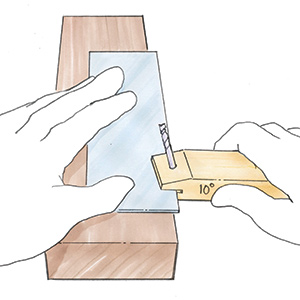
Synopsis: Wherever Tage Frid lectures on woodworking, people want him to demonstrate the care and use of a scraper. Here, he does just that, with a couple pages of explanations and two full pages of photos and directions. He talks about what types of scraper are available and how to find them, what they’re used for, how to hone the edges square and put a burr on the cutting edge. He says a scraper cuts sanding and finishing time in half, with a better result in the end.
The scraper is one of the most important and versatile tools for wood sculptors and cabinetmakers. It is available as a simple, rectangular piece of steel, called the scraper blade and as a blade mounted in a handle that looks like a large spokeshave called the cabinet scraper.
Sharpening and maintaining the scraper are simple, but do take practice to learn. Many people get frustrated and give up, but once you can maintain the proper edges you will wonder how you ever did without it. Whenever I lecture, people want me to demonstrate the care and use of the scraper because few are able to learn this on their own.
The same scraper blade can be used for crude and fine work, to scrape glue or to produce a high-gloss finish with lacquer or shellac. It is better than steel wool between coats of finish because it doesn’t leave tiny shreds of metal embedded in the pores of the wood. And when an old scraper gets too narrow to use it can become a tool for making half-blind or hidden dovetails.
The cabinet scraper has many uses too. It can remove old finishes without the use of solvents. It is excellent for removing paper after veneering and, like the scraper blade, it removes excess glue. If sharpened correctly it will put a fine finish on burl woods or delicate veneers.
The working edge of a scraping tool is the burr which does the actual cutting. Magnified, the burr resembles a small hook running the length of the edge. The scraper blade is sharpened by first filing the edges square. Then a medium stone removes the file marks. I prefer a wet/dry carborundum stone without oil. Then I use a honing stone, and here I prefer a Belgian clay water-stone, used with water. I hate to use oil because it mixes with particles from the stone and gets on my hands and the bench. Before I know it, the work too gets oily. The edge a water-stone produces is just as good as with an oilstone and it cuts the metal much faster. And if the stone wears hollow you can redress it yourself with sandpaper, by hand or machine.
After the edges are honed square the scraper is ready to have its cutting edge or burr put on. This is done by stroking the edge with a burnisher held at an angle of 85 ° to the face of the blade. A burnisher is a piece of steel that is harder than a scraper blade. The back of a chisel works just as well—I think even better—and I don’t have to buy another unnecessary tool.
From Fine Woodworking #6
For the full article, download the PDF below:
Fine Woodworking Recommended Products

Wen Diamond Grinding Wheel

Honing Compound

Veritas Wheel Marking Gauge






















Log in or create an account to post a comment.
Sign up Log in